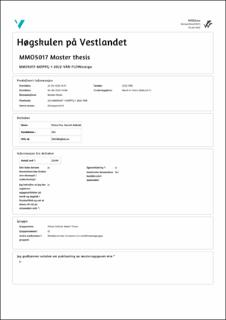| dc.contributor.author | Ankrah, Prince Paa Tawiah | |
| dc.date.accessioned | 2022-08-08T09:02:32Z | |
| dc.date.available | 2022-08-08T09:02:32Z | |
| dc.date.issued | 2022 | |
| dc.identifier.uri | https://hdl.handle.net/11250/3010570 | |
| dc.description | Master in Maritime Operations, Offshore and Subsea Operations Profile, Western Norway University of Applied Sciences | en_US |
| dc.description.abstract | Offshore wind power offers potential as a carbon neutral source of energy generation. For decades now, offshore wind technology has developed steadily, and Europe particularly has accelerated development and construction of wind farms off its coasts. Offshore wind structures have a finite design life, and, like the well-established oil and gas industry, offshore installations require sustainable decommissioning at the end of their life cycles. Many global institutions have set out to address the unintended risks this process may pose to the environment by researching and providing innovative solutions. Interreg North Sea (NSR) with its DecomTools project seeks to achieve two main objects which include reducing decommissioning cost and reducing carbon emission during the process significantly. As part of the project, a concept decomtool vessel design was developed to perform installation and decommissioning of offshore wind structures.
The aim of this thesis is to assess the technical feasibility of the monopile extraction system of the Decom Tools concept vessel for the decommissioning of offshore wind farms. The work initially presents a literature review of the current decommissioning operations for the offshore wind industry including current techniques developed for extracting monopile foundations. It subsequently addresses the aim of the research by assessing the technical feasibility of the concept decomtool vessel’s extraction system, focusing on the mechanical behavior of the support beam members of the gripper in response to the shear load during removal of the monopile from the seabed. It also assesses the Oxy-fuel cutting method and equipment for its suitability in terms of ease of use, ability to cut the steel monopile structure, estimated time for cut operation, and the minimum equipment space required. Finally, the vessel cranes' technical design parameters are evaluated for operational propriety under the present offshore wind decommissioning needs. The Horns Rev 1 wind farm monopile foundation was used as case study for estimations such as the cut time for monopile and crane capacity.
The finding of this research reveal that the gripper system support beams are unable to sustain the working loads during the extraction process, necessitating further research work to develop suitable support mechanism for the grippers. It also estimates the cutting time for a monopile and provides the footprints of the cutting equipment and gantry cranes. | en_US |
| dc.language.iso | eng | en_US |
| dc.publisher | Høgskulen på Vestlandet | en_US |
| dc.rights | Navngivelse 4.0 Internasjonal | * |
| dc.rights.uri | http://creativecommons.org/licenses/by/4.0/deed.no | * |
| dc.title | Technical Feasibility of Decomtools Vessel Monopile Extraction System | en_US |
| dc.type | Master thesis | en_US |
| dc.description.localcode | MMO5017 | en_US |

